High-Dose versus Low-Dose Oxytocin for Labor Augmentation: A Meta-Analysis of Randomized Controlled Trials
- PMID: 39063978
- PMCID: PMC11278403
- DOI: 10.3390/jpm14070724
High-Dose versus Low-Dose Oxytocin for Labor Augmentation: A Meta-Analysis of Randomized Controlled Trials
Abstract
Background/Objectives: Although oxytocin administration is recommended for delayed labor progress, there is no consensus over the preferred optimal dose of oxytocin. We aimed to perform a meta-analysis of pregnancy outcomes comparing high-dose versus low-dose oxytocin regimens for augmentation of delayed labor. Methods: PubMed, Embase, and Cochrane databases were systematically searched for studies comparing high-dose with low-dose oxytocin for labor augmentation from inception up to May 2023. The outcomes assessed were cesarean rate, instrumental delivery rate, postpartum hemorrhage, neonatal death, and uterine tachysystole. Subgroup analysis was performed with randomized controlled trials (RCTs) and propensity-matched studies. Statistical analysis was performed using Rstudio. Heterogeneity was assessed with I2 statistics, and a random-risk effect was used if I2 > 50%. Results: Twenty-one studies met inclusion criteria, and eighteen were RCTs. A total of 14.834 patients were included, of whom 7.921 (53.3%) received high-dose and 6.913 (46.6%) received low-dose oxytocin during labor augmentation. No statistical differences were found in cesarean delivery, neonatal mortality, postpartum hemorrhage and vaginal instrumentation rate. However, uterine tachysystole incidence was significantly higher with high-dose oxytocin (95% Cl, 1.30-1.94, p = 0.3; 0.6; I2 = 9%). Conclusions: Labor augmentation with a low-dose oxytocin regimen is effective as with a high-dose regimen, but with significantly less uterine tachysystole events, which can lead to intrauterine and neonatal complications. Our findings suggest that a low-dose regimen may be safe and effective for labor augmentation in medical practice.
Keywords: high-dose; labor augmentation; low-dose; oxytocin.
Conflict of interest statement
The authors declare no conflicts of interest.
Figures







Similar articles
-
High dose vs. low dose oxytocin for labor augmentation: a systematic review and meta-analysis of randomized controlled trials.J Perinat Med. 2020 Sep 21;49(2):178-190. doi: 10.1515/jpm-2020-0042. Print 2021 Feb 23. J Perinat Med. 2020. PMID: 32950965
-
High-dose versus low-dose of oxytocin for labour augmentation: a randomised controlled trial.Women Birth. 2019 Aug;32(4):356-363. doi: 10.1016/j.wombi.2018.09.002. Epub 2018 Oct 16. Women Birth. 2019. PMID: 30341003 Clinical Trial.
-
Intramuscular versus intravenous oxytocin for the third stage of labor after vaginal delivery to prevent postpartum hemorrhage: a meta-analysis of randomized controlled trials.Eur J Obstet Gynecol Reprod Biol. 2020 Jul;250:265-271. doi: 10.1016/j.ejogrb.2020.04.007. Epub 2020 May 12. Eur J Obstet Gynecol Reprod Biol. 2020. PMID: 32439242
-
The effect of early oxytocin augmentation in labor: a meta-analysis.Obstet Gynecol. 2009 Sep;114(3):641-649. doi: 10.1097/AOG.0b013e3181b11cb8. Obstet Gynecol. 2009. PMID: 19701046 Review.
-
Labor augmentation with oxytocin in low- and lower-middle-income countries: a systematic review and meta-analysis.AJOG Glob Rep. 2022 Oct 21;2(4):100123. doi: 10.1016/j.xagr.2022.100123. eCollection 2022 Nov. AJOG Glob Rep. 2022. PMID: 36387299 Free PMC article. Review.
References
-
- Iovino M., Messana T., Tortora A., Giusti C., Lisco G., Giagulli V.A., Guastamacchia E., De Pergola G., Triggiani V. Oxytocin Signaling Pathway: From Cell Biology to Clinical Implications. Endocr. Metab. Immune Disord. Drug Targets. 2021;21:91–110. doi: 10.2174/1871530320666200520093730. - DOI - PubMed
Publication types
LinkOut - more resources
Full Text Sources
Miscellaneous

